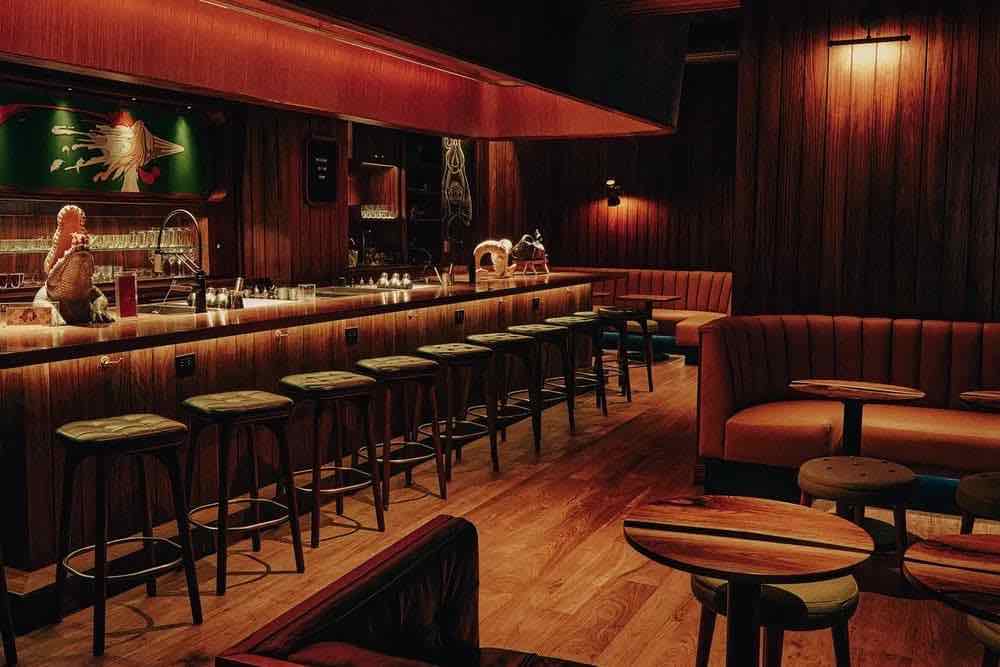Shanghai. When one hears of it, images of the skyline of the Pudong New District, with the orb of the Oriental Pearl Tower, the bottle opener that is the World Financial Center, and other buildings come to mind. Crowds, culture, busy streets. Shanghai is one of the largest and most vibrant cities in the world.
Shanghai has been China’s bastion of trade and commerce since as early as the 1840s, when Shanghai was first opened to foreign trade. It has become the home of the first foreign building, the first Western department store, the first Western pharmacy, and it was–and still is–home to one of the oldest cocktail bars in China, the Long Bar.
The famed bar, which has changed hands and held a number of names throughout its long history, lies on the Bund, the old center of commerce that today sits humbly in the shadows of its skyscraper-clad counterpart across the Huangpu River. Inside a tall gray and stone building with clock tower, columns and ornate decorations along its rooftop is where you’ll find the Waldorf-Astoria. And that’s where the Long Bar calls home. Although slightly smaller than the original, the bar itself is still impressive, marble topped and in a wood-paneled room with white ceiling, plush sofas and armchairs. And it still serves up some of the best cocktails in the city.

To understand the history of the bar, we must go back to before the skyscrapers and hustle and bustle of the modern megalopolis, when the Bund had only just begun. It was in 1910, when the building the bar resides in was opened for the Shanghai Club. Founded as a British-only gentlemen’s club in 1861, club members came to dine and drink at the 110-foot long bar (the longest in East Asia at the time) well into the 1930s. It was a place to compare fortunes and pass the time.
And so it continued until 1941, when war broke out in the Pacific and the Shanghai Club closed its doors. The club was reopened in 1956 and repurposed by the Chinese Communist Party, who turned the building into the Seamen’s Club, a bar catering to foreign sailors visiting the city.
The Seamen’s Club stood until the 1970s, when China was slowly opening to foreign investment and the economy transitioned to a capitalist one. In 1971 the building was purchased by a new owner and repurposed again as the Dongfeng Hotel. The old bar was demolished and became one of the only two KFC restaurants in Shanghai in 1989, which garnered some popularity for the hotel.

After the Dongfeng Hotel was acquired by the Hilton Group in 2009, it became the Waldorf-Astoria Shanghai on the Bund. Following refurbishing and reconstruction that lasted until 2011, the Long Bar was finally restored to its former glory, with a still-quite-lengthy bar measuring just shy or the original at 104 feet, yet with the same sophistication and service of years past.
Besides the plush seating, the raw oyster bar occupying the west end of the bar, and even the fact that they have a selection of rare whiskeys–some of them from mothballed distilleries–you’re coming here for the cocktails. Alongside a menu of modern and old classics, a handful of house creations and seasonal offerings, the bar has recently taken things up a notch by expanding their martini offerings and aligning their classics, from the Manhattan to the Sazerac to the Ramos Gin Fizz, with recipes in the 1932 Waldorf Bar Book.

Along with these tweaks come new additions inspired by the bar’s colorful history. These include the Chamomile London Martini, a cocktail made with honey syrup and chamomile tea that pays homage to the Shanghai Club patrons’ fondness of adding tea and spices to their punch; and the Colonel Sander’s Margarita, with its bacon-infused tequila, pineapple-lemongrass puree, triple sec, lime and bitters, which acts as a window to the bar’s days as a KFC.
Even with all the changes in recent years, the Long Bar remains a classic. And should you make your way to Shanghai, it’s one of the finest spots to sample the modern city’s historic past with a cocktail in hand. Enjoy your surroundings, sip on a well-made beverage and collect a good story while you’re at it.




Very interesting piece. I shall have to visit some of Shanghai’s old luxury sometime.